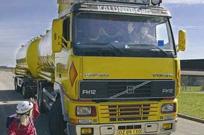Blind-spot mirrors give drivers a better view of what's alongside the vehicle. With conventional mirrors, drivers can't always see people, bikes and cars that are right next to them, especially when turning a corner.
Blind spots are areas around a vehicle that the driver can't see by looking through windows or in conventional mirrors. Blind spots are a major factor in many accidents involving lorries – when drivers are unable to see motorbikes, cycles or pedestrians, particularly when the lorry is turning right (or left in countries that drive on the left: Ireland, Cyprus, Malta and the UK).
To reduce the number of accidents, EU law requires lorries to be fitted with blind-spot mirrors that give drivers a wider field of vision than conventional mirrors.
Under EU law, blind-spot mirrors have been mandatory for new lorries since 2007, and older lorries have had to be fitted with them since 2009. (The relevant EU Directives don't apply directly but require national governments to pass legislation making the mirrors mandatory).
Blind-spot mirrors have already helped reduce the number of accidents involving lorries and motorcyclists, cyclists or pedestrians.
Studies & reports
In 2012 the Commission carried out a study into the effect of retrofitting blind spot mirrors to old lorries and reported to the European parliament and the Council. The study and the Commission's report can be consulted here:
Study on implementation of retrofitting directive: blind-spot mirrors (2012)
Report on implementation of Directive 2007/38: retrofitting blind-spot mirrors (2012)
The study carried out by in 2004 to decide on the retrofitting of mirrors can be consulted here:
Impact assessment study for the 2007 retrofitting Directive (2004)
Useful links
Legislation
- Regulation No 46 of UNECE — Uniform provisions concerning the approval of devices for indirect vision and of motor vehicles with regard to the installation of these devices
- EU directive 2005/27/EC – adaptation to technical progress
- EU Directive 2007/38/EC – retrofitting mirrors to heavy goods vehicles

